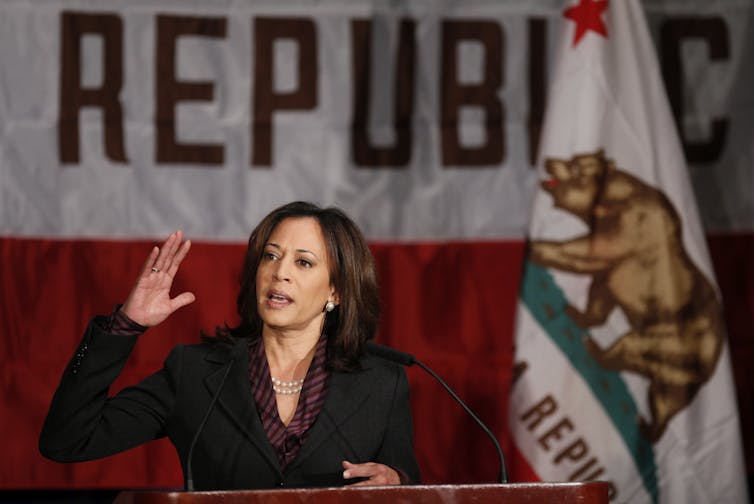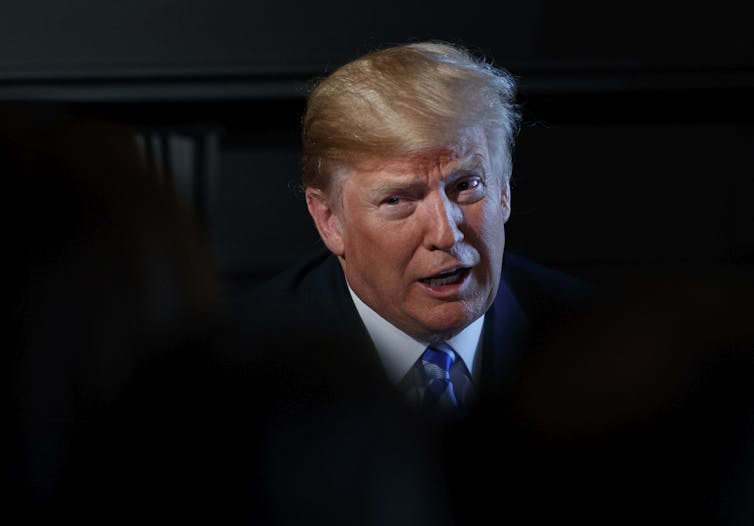On crime and justice, Trump and Harris records differ widely
There are substantial differences between the two candidates, though each of their records contains some interesting twists and turns.
Though crime and criminal justice policy are central issues in many elections, that’s not true in 2024. Surveys show that relatively few American voters rank crime as their most important concern.
Yet both former President Donald Trump and Vice President Kamala Harris say they take those problems seriously. Trump and the Republicans have focused attention on the problem of illegal immigration and the crimes that he says immigrants commit.
Harris, as The Economist noted, “is using her history as a prosecutor in San Francisco to burnish her tough-on-crime bona fides.” She has mentioned that background in connection with immigration, drug policy and corporate wrongdoing.
As someone who studies crime and justice in the United States, it is clear to me that there are substantial differences between the two candidates, though each of their records contains some interesting twists and turns.

Kamala Harris, the prosecutor
Harris has a long record of working in the criminal justice system. She worked in the Alameda County district attorney’s office in California, starting in 1990, where she specialized in child sexual assault cases. She then served as district attorney in San Francisco from 2004 to 2010 and as attorney general of California from 2010 to 2017, when she was elected to the U.S. Senate.
Axios reported that during her term as district attorney, “the number of violent crimes rose steadily in the city of San Francisco during her first five years in office then fell 15% in her last two years.” And when she served as the state’s attorney general, “the violent crime rate in the state was 439.6 per 100,000 residents the year before she took office and fell to 396.4 by 2014. … However, violent crime surged to 444.8 in 2016 during her last year in office to a six-year high,” Axios reported.
In both offices, Harris undertook a number of reforms in criminal justice policy.
For example, in San Francisco she developed a “Back on Track” initiative“ that aimed to help nonviolent drug offenders between the ages of 18 and 30. According to The New York Times, its key promise was that ”after a full year of employment, education, community service, regular meetings with a supervising judge and crime-free behavior, the charge would be expunged from the offender’s record.“ It was generally well received, especially among progressives.
When Harris became the state’s attorney general, she reformed California’s approach to school truancy by focusing on the parents of truant children. As The New York Times reported, she threatened them ”with fines or even imprisonment if they did not ensure that their children attended class.“ FactCheck.org found that as a result of her policy, ”district attorneys reported prosecuting 3 to 6 … cases per year,“ on average.
Considering Harris’ record in California, The Desert Sun (Palm Springs, California) said Harris ”earned a reputation as tough on sexual abuse, human trafficking and organized crime, and did not shy away from pursuing incarceration.“
Throughout her career, Harris has been an opponent of the death penalty. During her first campaign for San Francisco district attorney, she promised that she would never seek a death sentence no matter how heinous the crime. She stuck to that promise, but as attorney general she went to court to defend death sentences that had been imposed under prior administrations.
The Los Angeles Times said her decision to do so was an appropriate one for the attorney general, ”putting professional responsibility over personal politics.“
CNN summarized her record on capital punishment by saying it ”broke hearts on both sides.“

Donald Trump’s record as president
Trump, by contrast, was a strong proponent of the death penalty during his time in the Oval Office. In March 2018, he directed the Department of Justice to seek the death penalty in cases involving drug traffickers. The department also vigorously pursued new death penalty prosecutions in other areas and defended existing death sentences in court.
After a long time without any federal executions, the Trump administration carried out 13 of them in the last seven months of his term. ProPublica said Trump’s administration ”executed more federal prisoners than any presidency since Franklin Delano Roosevelt’s" and more than the prior 10 presidents combined.
In other areas, the Trump administration stepped in to stop some criminal justice reform initiatives. For example, according to ABC News, Trump’s first attorney general, Jeff Sessions, stopped former President Barack Obama’s effort to end prison privatization, and then began distributing contracts for new privately run detention centers.
But during his presidency, Trump was not consistent in being tough on crime. For instance, in March 2018, he signed an executive order creating the Federal Interagency Crime Prevention and Improving Reentry Council. He charged it with identifying ways “to provide those who have engaged in criminal activity with greater opportunities to lead productive lives” and to develop “a comprehensive strategy that addresses a range of issues, including mental health, vocational training, job creation, after-school programming, substance abuse, and mentoring.”
The Biden administration built on and extended those efforts.
And in December 2018, Trump supported the so-called “First Step Act,” which passed Congress with bipartisan support. It funded efforts to reduce the likelihood that inmates would be convicted again after their release, including by providing addiction treatment, mental health care, education and job training.
Trump also commuted the sentences of more than 90 people and pardoned more than 140 others. His use of clemency power was quite controversial, as some of its beneficiaries were Trump associates, such as Steve Bannon and Paul Manafort, who led Trump’s 2016 presidential campaign and had committed financial fraud.
As far as the crime rate during Trump’s presidency, the Dallas Morning News reported that “During the first three years of Trump’s presidency, the violent crime rate per 100,000 population … fell each year. But, the Morning News – citing Politifact – said that in 2020, "the violent crime rate spiked,” though it was slightly lower than it had been in Obama’s final year in office.
Crime and criminal justice in the next administration
The next president will have choices to make about the crime and justice policies that the federal government will pursue and about whether to emphasize reform or harsh punishment. He or she will also have to decide whether, and how, the federal government should use grants and other funding, guidelines and enforcement to further those goals.
Their records suggest that Harris and Trump would make very different choices about those and other crime and criminal justice issues.
Austin Sarat does not work for, consult, own shares in or receive funding from any company or organization that would benefit from this article, and has disclosed no relevant affiliations beyond their academic appointment.
Read These Next
The Supreme Court’s decision on birthright citizenship will depend on its interpretation of one phra
Advocates for each side will provide a different explanation for who falls under ‘the jurisdiction’…
Vaccine committee votes to scrap universal hepatitis B shots for newborns despite outcry from childr
The decision undoes a highly effective 34-year prevention strategy that has nearly eliminated early…
Far-right extremists have been organizing online since before the internet – and AI is their next fr
Neo-Nazis and other far-right extremists were early adopters of bulletin board systems, pioneering online…





